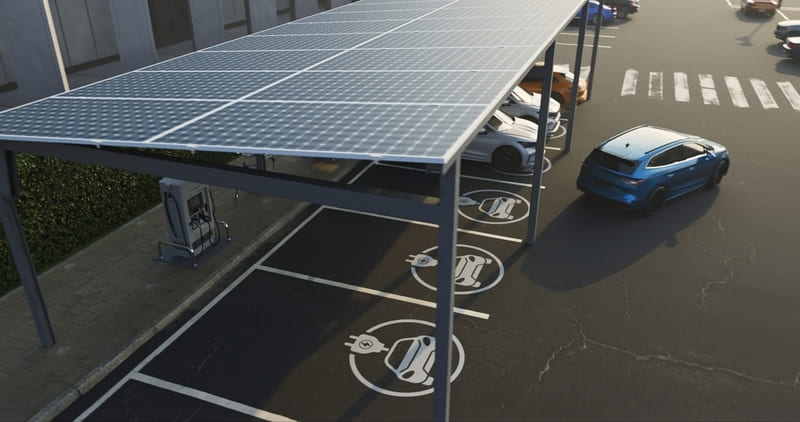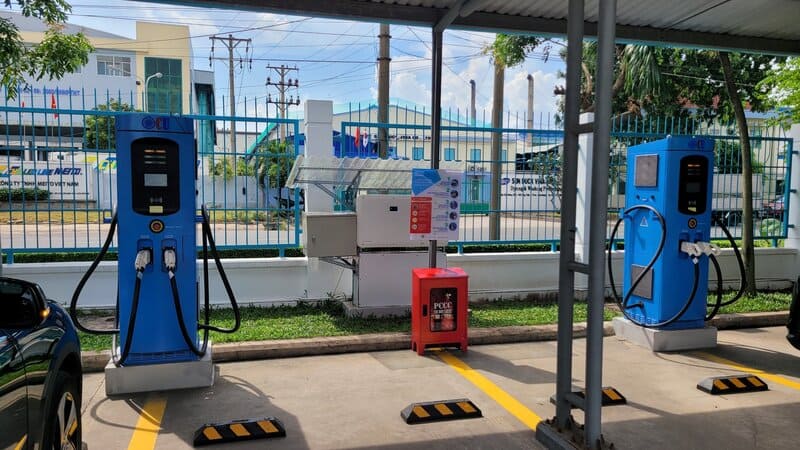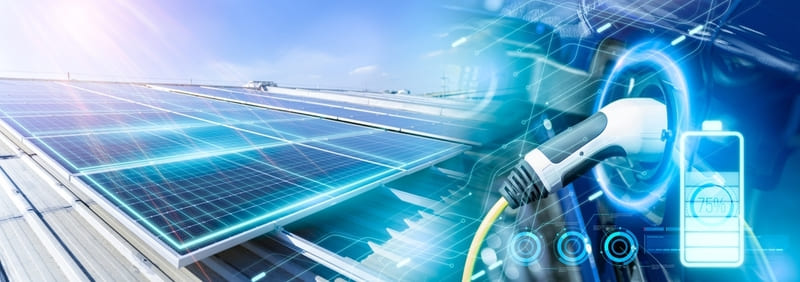Nội dung bài viết
Electric vehicle transition is considered an inevitable development trend of global transportation, but is also a challenge for each country’s transportation infrastructure, especially the power transmission grid. At this time, developing a model that both effectively uses renewable energy and protects the environment such as a solar charging station will solve most of the disadvantages of traditional charging stations, while promoting the sustainable transition of the electric vehicle industry.
What is a solar charging station?
Solar Powered Battery Charging Station is a type of charging station service that uses 100% renewable energy from photovoltaics or combined with grid power to provide the necessary energy for electric vehicle batteries.

Solar charging stations are considered an innovative, sustainable energy solution capable of solving the power crisis when electric vehicles become a trend in the global transportation industry, while reducing the load on the national power grid and promoting the use of clean energy to combat climate change.
Currently, solar charging stations are installed in many areas such as:
- Residential areas: Usually private charging posts, serving slow overnight charging for households’ daily electric vehicle needs.
- Highways and national highways: Most are fast chargers with a capacity of over 40kW. This is the most ideal location to install a photovoltaic charging station.
- Rest stops: Including both fast charging and slow charging types to serve the needs of many different customers.
Structure and operating principle of solar charging station
The typical structure of a photovoltaic charging station includes the following components:
- Solar battery system: Responsible for absorbing sunlight and converting it into electricity (direct current).
- Inverter: Solar cells can only generate DC current while electric vehicle charging stations require alternating current input. The inverter has the function of converting DC to AC to power the charging station.
- Electric vehicle charger: Responsible for safely transferring the electricity generated from the panels to the electric vehicle battery.
- Storage battery: Helps store energy to power electric vehicle batteries when needed. When the vehicle is disconnected, power is conserved in the battery system.
In terms of operating principle, the solar charging station operates according to the following process:
- Convert sunlight into electricity: Solar panels will absorb photovoltaics and generate direct current.
- Current change: The DC current will then be converted into AC current by the inverter to power the charging station.
- Energy Storage: When there is a lot of sunlight, the electricity generated from the panels will be provided directly to battery-powered vehicles. If there is excess, the energy will be stored in storage (battery or lithium battery) for use at night or when there is little light. When the battery is full, the remaining energy will be fed into the grid. In case the battery system does not provide enough capacity for the electric vehicle, the grid-connected charging station will draw electricity from the national grid.
Classification of solar charging stations

There are two common types of photovoltaic charging stations: grid-connected charging stations and off-grid charging stations.
Grid-connected solar charging station
This type of photovoltaic charging station model will be combined with the power grid. When the electricity generated from sunlight stored in the battery is used up, the system will automatically switch to using grid electricity to charge the vehicle.
The outstanding advantage of a grid-connected solar charging station is that it always provides enough energy for electric vehicles even on days with little sunshine or at night. However, this charging station depends on the power grid so it needs to be installed in an area with a stable power source.
Off-grid solar charging station
The off-grid photovoltaic charging station uses electricity entirely from solar energy to serve EV vehicles, so it has the ability to operate independently, independent of the national power grid.
The advantage of an off-grid charging station is that it can be installed anywhere, as long as there are suitable lighting conditions and space area. This is considered the perfect electric vehicle charging solution in areas where there is no electricity grid or the power supply is often intermittent. However, to meet charging needs on cloudy days or rainy seasons, charging stations need to have a solar battery system and storage battery large enough, accompanied by a structure strong enough to withstand the weight of the solar energy-absorbing panels.
The role of solar charging stations

Reduce load on the national power grid
Traditional electric vehicle charging stations depend mainly on the national power grid, causing the transmission grid to be under great pressure, especially during peak hours or hot seasons. Meanwhile, photovoltaic charging stations use solar energy and are little or not affected by grid power, so they can charge the vehicle’s battery at any time, thereby reducing the load on the power grid and ensuring sustainable energy security.
Save costs
Although the investment cost is high, in terms of long-term benefits, the operating cost of a photovoltaic charging station can be saved up to 70% compared to a traditional charging station (according to SolarEV’s calculations). The reason is because electricity prices can increase over time, while solar power fees are constant.
Effectively exploit clean energy sources
Solar energy is renewable energy. Off-grid photovoltaic charging stations use completely clean energy, minimizing greenhouse gas emissions, contributing to more efficient use of natural energy sources, limiting dependence on fossil energy.
In addition, solar charging station systems can be installed in a variety of terrains and areas, so they can take advantage of the abundant and free resource of sunlight.
Promote sustainable transportation
Electric vehicles are already a sustainable transportation solution, and when combined with solar charging stations, they are even more effective in protecting the environment. The birth of photovoltaic charging stations solves the concern of the power grid being overloaded and charging fees increasing with electricity prices, accelerating the trend of shifting from gasoline cars to electric cars in each country.
Development potential of solar charging stations in Vietnam
Vietnam is not only a “hot” market for electric vehicles but also has great potential to develop a photovoltaic charging station model.
Abundant solar energy sources
Vietnam belongs to a typical tropical climate zone, so it has favorable energy sources to develop solar power to serve electric vehicles:
- Sunny all year round: Vietnam has quite long daily sunshine hours, with a capacity of 4-5 kWh of light per day/m2 of territory, especially in the Central and Southern regions.
- High radiation intensity: Ranging from 1,500 – >1,800 kWh/m²/year, suitable for solar battery installation.
Demand for electric vehicles is increasing
The speed of conversion to electric vehicles in Vietnam is considered to be the fastest in Southeast Asia, including the number of electric vehicles and the number of charging posts. A report from the World Bank said that by 2030, Vietnam will need at least 50,000 charging stations with about 800,000 charging ports to serve the needs of 1 million electric vehicles.

However, most current charging stations use electricity from the national grid, so as the number of electric vehicles increases, the pressure on the transmission grid also increases exponentially. Therefore, the potential to diversify charging station models, including photovoltaic charging stations in Vietnam, is huge to ensure sustainability and energy security for electric vehicle infrastructure.
Government goals
At COP26, Vietnam committed to bringing net emissions to NetZero by 2050. Therefore, the transition to electric vehicles combined with expanding the renewable energy charging station model is necessary and urgent.
In addition, Vietnam also sets a goal that by 2030, 50% of office buildings and 50% of residential homes will use self-produced and self-consumed rooftop solar power, so investing in photovoltaic charging stations at this time is completely feasible.
Solar charging station model currently available in Vietnam
SolarEV is currently one of the most active businesses in deploying the photovoltaic charging station model in Vietnam. SolarEV charging stations are mainly DC fast charging stations with a capacity of 60 – 250kW, with the ability to store 100 – 2000kWh and operate independently of the grid.

In particular, SolarEV’s photovoltaic charging posts are also equipped with smart technology (touch screen, Internet connection, charging app) allowing users to search for charging points, monitor the charging process and pay online.
Worth mentioning, SolarEV not only appears on highways, national highways, and rest stops to serve the needs of fast and clean charging, but can also be installed at home with reasonable operating costs.

Are solar charging stations the future of the EV industry?

A report from the International Energy Agency (IEA) said that the number of electric vehicles sold in 2024 increased by 3.5 million units compared to 2023 and will likely reach 20 million units by the end of this year. In particular, in developing countries in Asia, Latin America and Africa, the electric vehicle market is even more vibrant.
To meet the need to shift from gasoline cars to electric cars, many governments have also invested heavily in electric vehicle charging station infrastructure. Typically, the number of public charging points in Europe reached the 1 million mark by the end of July 2025 (data from EV Belgium). The number of public charging points in the US has also increased by 72% compared to the previous year. China alone currently has 12 million charging points.
However, the world’s charging station infrastructure in general still cannot meet the development scale of the EV industry due to a number of inadequacies related to legal factors, development strategies of each country and limitations in the power transmission grid. Therefore, the birth of solar charging stations will help solve the problem of overloading the power grid, reduce dependence on fossil energy sources, especially use more effectively the sustainable energy source of sunlight.
Not to mention, the investment cost for photovoltaic charging stations, in the long run, is much more economical than traditional charging stations, so the trend of solar charging stations can be considered the future of a sustainable EV industry, both environmentally friendly and overcoming the disadvantages of conventional charging stations.
The problem is that solar power depends mainly on weather conditions and sunlight, so without a large enough solar battery and storage battery system, off-grid photovoltaic charging stations will find it very difficult to serve charging needs during the rainy season or when weather conditions are bad. In addition, solar panel systems also require a spacious installation space, which can be a challenge for urban areas and densely populated cities.
Some questions about solar charging stations
Question 1: Are solar charging stations cheaper than traditional charging stations?
Reply: Have. According to SolarEV statistics, the investment cost for a photovoltaic charging station may be greater than a traditional charging station, but the transportation cost is up to 70% more economical. At the same time, the charging fee of a solar charging station is also up to 30% cheaper than a conventional charging station. So in terms of long-term value, investing in photovoltaic charging stations is an ideal and sustainable solution.
Question 2: Can the photovoltaic charging station charge many types of vehicles?
Reply: Have. Photovoltaic charging stations are often equipped with Type 2 charging ports for AC charging and CCS combo Type ports for DC charging, so they are compatible with many types of electric vehicles.
Question 3: Are the maintenance costs of photovoltaic charging stations high?
Reply: Are not. Maintenance costs for solar charging stations are relatively low, mainly cleaning solar panels and checking electrical connections.


Nội dung được phát triển bởi đội ngũ truonglehongphong.edu.vn với mục đích chia sẻ và tăng trải nghiệm khách hàng. Mọi ý kiến đóng góp xin vui lòng liên hệ tổng đài chăm sóc: 1900 0000 hoặc email: hotro@truonglehongphong.edu.vn